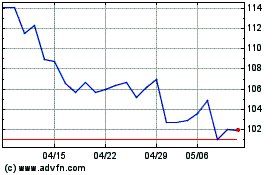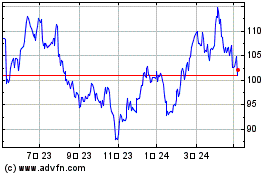By James Rundle
In the corporate world, the point of 5G wireless service goes
far beyond faster internet access.
True, 5G, short for fifth-generation wireless, is up to 100
times faster than current 4G connectivity. But even though 5G is
still in its infancy, the technology has the potential to reshape
how companies in a range of fields manage their technology --
everything from factory floors to farming.
5G uses higher frequencies and a much broader chunk of the radio
spectrum than previous generations -- which means that it can send
more data more quickly, and to more devices, than has been possible
in the past. That creates the potential to open up new business
models, in which more wirelessly connected data-gathering sensors
and intelligence are deployed in the field.
One early use of the technology is enabling the enhanced use of
robotics and automated devices on factory floors. Machines can be
operated remotely with much more ease because there isn't as much
lag in their performance, and they can be linked together and
managed much more easily.
In Europe, auto manufacturers including Bayerische Motoren Werke
AG and Volkswagen AG plan to apply for licenses to operate private
5G networks within their facilities.
"The BMW Group sees great potential for production in the new 5G
standard," a spokesman for BMW says.
Volkswagen, which didn't respond to a request for comment, has
previously said that it operates around 5,000 robots at its
Wolfsburg plant in Germany and will require 5G's capabilities to
control these and other internet-connected machinery, such as
autonomous vehicles.
Industrial companies are also interested in 5G because the
technology allows a degree of operating flexibility that isn't
possible with current infrastructure, says Scott Gravelle, chief
executive and chief technology officer at Attabotics Inc., based in
Calgary, Alberta, which provides robotic fulfillment centers for
retailers and other businesses.
For example, a box maker in a traditional factory is usually
networked by physical wiring to other components, such as
programmable logic controllers that coordinate machine activities.
With the reduction in lag, or latency, and the stability afforded
by a private 5G network, those devices, and more of them, can
become wirelessly internet-connected and easy to move, without the
need to hard-wire and re-engineer connections, Mr. Gravelle
says.
"The amount of flexibility that gets delivered in industrial 5G
networks is almost limitless compared to legacy architecture," he
says. Wireless 5G connections enable equipment to be swapped out
with comparative ease, he says.
Telecommunications-equipment provider Ericsson AB's facility in
Lewisville, Texas, which began operations in March, is among the
earliest examples of a 5G-connected factory. It uses 5G to enable
large-scale automation in warehousing and production-line
operations, and the network allows the use of video and radio
sensors in all parts of the manufacturing process for tasks such as
fault detection. Bringing all this technology to bear wouldn't have
been possible over a broadband Wi-Fi network or other network
standards, owing to the instability and limitations of those
technologies, says Erik Ekudden, Ericsson's chief technology
officer.
"Previous generations of technology were not capable
enough....You wouldn't have completely re-engineered or built a
factory only on 3G, or for that matter, a 4G network," he says. A
5G base station was the first product to roll off the factory's
line.
Entertainment and sports
Intel Corp. has worked on a range of 5G projects, according to
Caroline Chan, vice president of Intel's Data Center Group and
general manager of the group's Network Business Incubator Division.
These include an Orlando, Fla.-based theme park, which she didn't
name, where visitor experiences are rooted in augmented and virtual
reality, underpinned by a 5G network that can provide low-latency
connections and handle the data transmission requirements of the
attractions.
Manish Vyas, president of the communications, media and
entertainment unit within Indian conglomerate Mahindra &
Mahindra Ltd.'s Tech Mahindra business, and chief executive of its
network-services division, says that the range of early uses for 5G
it has been involved with include drone-enabled pipeline
inspection, fleet management in mines and telemedicine, among
others.
Early deployments in the consumer space have, so far, largely
centered on specialized applications, such as fan experiences at
sporting events and early experiments with augmented and virtual
reality. The ability to quickly configure and subdivide 5G networks
according to needs, rather than installing entirely new connections
as with 4G, is proving to be a boon to companies such as event
organizers.
The network's edge
Many of these 5G applications are based on the idea of edge
computing, in which a combination of sensors and analytical
software can be deployed even in remote locations, such as farms or
other rural areas.
Edge computing allows information to be processed at the point
it's collected rather than having to travel to central servers --
but it will require 5G to facilitate its vast data and connectivity
requirements. Convoys of autonomous vehicles, for example, require
fast and stable connections to receive necessary data, such as
traffic updates, information on road conditions and vehicle
status.
Artificial intelligence and the burgeoning array of connected
devices known as the Internet of Things, too, will substantially
benefit from 5G's speed and capacity. Sensors used widely in smart
cities to measure a wide array of conditions will require 5G's
connectivity to function on the scale required, for instance,
although these technologies are still early-stage, and will take
time to develop.
Mr. Rundle is a reporter for WSJ Pro Enterprise Technology. He
can be reached at james.rundle@wsj.com.
(END) Dow Jones Newswires
November 10, 2020 12:11 ET (17:11 GMT)
Copyright (c) 2020 Dow Jones & Company, Inc.
Bayerische Motoren Werke (TG:BMW)
過去 株価チャート
から 3 2024 まで 4 2024

Bayerische Motoren Werke (TG:BMW)
過去 株価チャート
から 4 2023 まで 4 2024
